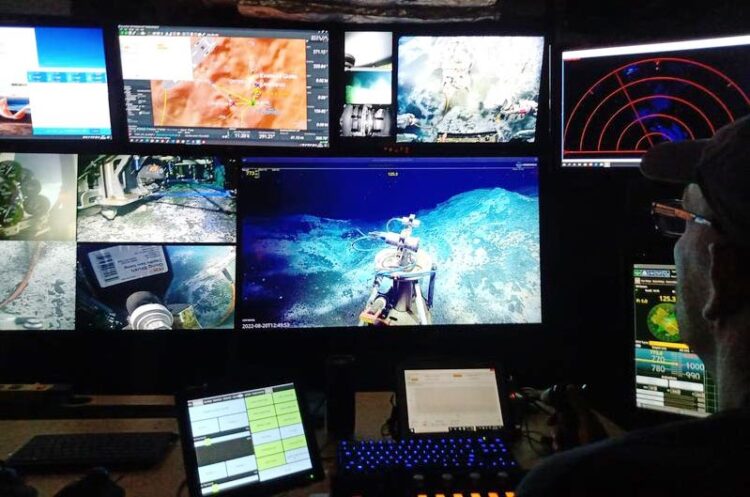Expedition to long-term observatory off Oregon

The MARUM camera installed at the ocean floor on the control screens of a remotely operated diving robot.
Credit: MARUM, Eberhard Kopiske; ROV: ROPOS
MARUM team retrieves deep-sea observatory developed in Bremen.
How much methane escapes from the ocean floor? This question is the focus of an international project in which MARUM – Center for Marine Environmental Sciences at the University of Bremen is also involved. An expedition to the underwater observatory off the west coast of the USA is now starting, at the end of the M³ project (Sonar Monitoring of Marine Methane emissions), with the research vessel THOMAS G. THOMPSON and the diving robot JASON.
Methane acts as a powerful greenhouse gas when it enters the atmosphere. While methane emissions on land are comparatively easy to estimate, this is more difficult for submarine gas emissions in the oceans. An underwater observatory within the Ocean Observatory Initiative (OOI) helps to continuously measure methane gas emissions and their variability at Southern Hydrate Ridge on the upper continental slope off Oregon.
MARUM is involved in this initiative and has developed sonar systems specifically to detect methane emissions, which emerge from the seafloor as gas bubbles. The equipment was installed six years ago and the data generated were collected remotely via the OOI deep-sea cabled array and stored in near real-time at the MARUM in Bremen. The instrument could also be controlled remotely and reprogrammed as needed via the same cabled connection.
Initial results of the long-term monitoring now indicate that the amount of escaping gas can vary greatly. This is due in part to pressure and bottom current variations caused by the east Pacific tides off the west coast of the USA. Southern Hydrate Ridge where the observatory is placed is one of the very active methane seepage areas on the continental margin of the Cascades mountain range of North America.
“It is impressive to see how much a tidal amplitude of only 3 meters can affect the onset and cessation of deep-sea methane emissions located under 800 plus meters water depth. But tidal pressure is one factor controlling the gas release and there is some high frequency variability which cannot be explained solely by the tides. Thanks to the cabled infrastructure, we discovered that the seabed shape is extremely dynamic and causes a hardly predictable local variability. It is important to comprehend this variability when estimating fluxes of marine methane,” explains Dr. Yann Marcon, project manager from MARUM.
On the expedition that starts on August 23 in Newport, Oregon, diving robot JASON (Woods Hole Oceanographic Institution) will be used to maintain the observatory and to document the condition of the equipment and the site of operation. From MARUM, Eberhard Kopiske and Jan Gümpel will be on board the research vessel RV THOMAS G. THOMPSON.
This expedition marks the end of the M³ project, which ran in two phases over six years. During this time, equipment developed at MARUM has been installed and operated on the ocean floor. Currently, a camera observatory, a probe for measuring oceanographic parameters and an acoustic sonar are part of the Bremen deep-sea instrumentarium. During the “Visions23” expedition, all MARUM instruments will be recovered and brought back to Bremen.
The M³ project is funded by the German Federal Ministry of Education and Research (BMBF).
The expedition to the ocean floor observatory can be followed in a live stream: https://interactiveoceans.washington.edu/visions-23-live-video/
MARUM produces fundamental scientific knowledge about the role of the ocean and the ocean floor in the total Earth system. The dynamics of the ocean and the ocean floor significantly impact the entire Earth system through the interaction of geological, physical, biological and chemical processes. These influence both the climate and the global carbon cycle, and create unique biological systems. MARUM is committed to fundamental and unbiased research in the interests of society and the marine environment, and in accordance with the Sustainable Development Goals of the United Nations. It publishes its quality-assured scientific data and makes it publicly available. MARUM informs the public about new discoveries in the marine environment and provides practical knowledge through its dialogue with society. MARUM cooperates with commercial and industrial partners in accordance with its goal of protecting the marine environment.
Wissenschaftliche Ansprechpartner:
Dr. Yann Marcon
General Geology – Marine Geology
MARUM – Center for Marine Environmental Sciences, University of Bremen
Phone: 0421 218-65057
Email: ymarcon@marum.de
Weitere Informationen:
http://www.marum.de/en/Discover/MARUM-deep-sea-sonars-on-Underwater-Observatory….
http://www.marum.de/en/Discover/Team-maintains-deep-sea-instruments-on-cabled-ob…
http://www.marum.de/en/Discover/Maintenance-of-observatory.html
http://www.marum.de/en/Discover/Submarine-cabled-observatory-reveals-highly-vari…
Media Contact
All latest news from the category: Earth Sciences
Earth Sciences (also referred to as Geosciences), which deals with basic issues surrounding our planet, plays a vital role in the area of energy and raw materials supply.
Earth Sciences comprises subjects such as geology, geography, geological informatics, paleontology, mineralogy, petrography, crystallography, geophysics, geodesy, glaciology, cartography, photogrammetry, meteorology and seismology, early-warning systems, earthquake research and polar research.
Newest articles

How Geothermal Energy Shapes Bavaria’s Green Future Through Sustainable Energy
The Bavarian State Ministry of Science and the Arts has extended its funding for the research association “Geothermal Alliance Bavaria,” with the University of Bayreuth (UBT) continuing as a member…

Spintronics memory innovation: A new perpendicular magnetized film
Long gone are the days where all our data could fit on a two-megabyte floppy disk. In today’s information-based society, the increasing volume of information being handled demands that we…

Materials with a ‘twist’ show unexpected electronic behaviour
In the search for new materials that can enable more efficient electronics, scientists are exploring so-called 2-D materials. These are sheets of just one atom thick, that may have all…



